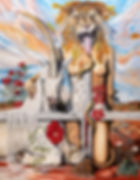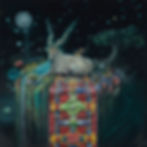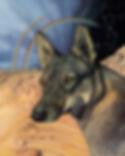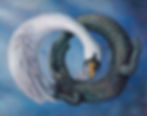An interview with: Marlene Seven Bremner
- Brandon Pestano
- Jul 21
- 10 min read
Updated: Jul 22
Presenting an enlightening in-depth conversation with @m7artist
"Marlene Seven Bremner was born in Frankfurt, Germany in 1983. She has a BA in Geography and Environmental Studies and is trained as a Polarity Therapist by the Institute of Holistic Health Careers. She is a self-taught oil painter, author, poet, and musician, exploring esoteric themes arising from her study and practice of Hermeticism, alchemy, magic, astrology, and mythology. Seven developed her painting career in the Pacific Northwest, showing her work in both group and solo exhibitions along the West Coast and internationally, and now resides in the desert of New Mexico. She is the author of Hermetic Philosophy and Creative Alchemy: The Emerald Tablet, the Corpus Hermeticum, and the Journey Through the Seven Spheres (Inner Traditions, 2022), and The Hermetic Marriage of Art and Alchemy: Imagination, Creativity, and the Great Work (Inner Traditions, 2023)." - marlenesevenbremner.com
Read on below for the full interview...

Where are you currently based and how has 2025 been for you so far? are there any particular ideas or concepts that have captivated you in recent times that you wish to disclose?
I’m currently based in Santa Fe, NM. I moved into town in the summer of 2024 after spending the previous five years living on a very rustic and beautiful property out in the desert of northern New Mexico. It’s been quite an adjustment to be back in an urban setting. So far 2025 has been a challenging year, both on a personal level with some big changes in my life, and also collectively with the unfolding situation in the US and the state of the world. It’s been a lesson in holding space for an overwhelming and heartbreaking world and doing what I can to support positive change, while deepening into my connection with Self and Cosmos. One of the subjects I’ve been captivated by in recent months is the daimōn, the ancient Greek concept similar to the Roman “genius,” a guardian spirit assigned to the individual at birth that accompanies them throughout life, acting as a guide to keep them on track with their fate.

The daimōn also plays the role of psychopomp at death, guiding the soul to the place of judgment. In the Hermetic texts the daimōn is the judge overseeing where the soul goes at death based on how they’ve lived their life. My interest in the daimōn was piqued after a spontaneous painting came through a couple of years ago, which I completed toward the end of 2024. I named the painting The Annunciation of the Daimōn and it portrays a rainbow-winged, dragon-headed being with goat legs, who I came to recognize as the daimōn. It is descending to announce the birth of new creative life within the other subject in the painting, a woman with the head of an ibis skull. When the painting came through initially, it had the feeling of the Annunciation of the archangel Gabriel to the virgin mother, and I see it in this way. Except in my case, the virgin birth was really a creative renewal after a period of disconnection and uncertainty. I believe that this painting has helped me to connect with my own daimōn and to make some necessary shifts in my life to live in a more authentic way, and to stay aligned with my purpose.

What are some of the key lessons that your studies in Hermeticism have taught you?
I think the most central lesson I have received from my studies in Hermeticism is the understanding that everything is connected within the One Mind, and that we as individuals have so much power to affect the collective in both subtle and profound ways through the imagination. Additionally, understanding the harmony of fate and the influence of the seven planetary fate spheres as these primordial, archetypal forces that guide and manipulate us unconsciously has been a big part of my work. The three branches of Hermeticism—alchemy, astrology, and magic—are methods for understanding the true nature of the Self and to transmute one’s experience of reality for a more fully integrated and engaged relationship to life. Working with these in my practice has given me a sense of creative agency and helped me to feel more empowered in the world.

Could you describe what the concept of 'creative alchemy'; means to you on a personal level and within the context of your art in relation to Jungian archetypes, duality, the imagination, and how these areas interweave?
I see my studio as my laboratory, and the canvas (or the guitar, journal, or computer) as the vessel in which the alchemical work is taking place. There may be multiple alchemical processes unfolding in different areas of my laboratory, and my work is to pay attention to where my involvement is needed. I may have a song distilling for a long time, and all I need to do is keep the heat of my attention on it as the lyrics or guitar parts slowly distill into their refined essence. Meanwhile I might have a very cathartic calcination unfolding inside of me that requires a blank canvas for me to unleash that intensity on. A lot of my paintings begin with a sort of fiery expression, and then this becomes a longer alchemical digestion during which I refine the painting and eventually arrive at a more sublime image. The core of the alchemical work is the transmutation of the soul into its most ennobled expression, which is externalized as the transmutation of base metals into gold. A fundamental part of this process is the unification of opposites, and this is usually symbolized by the Rebis, from res bina, latin for “double matter” or “two-thing.” Or it may take the form of the Divine Androgyne, or Hermaphrodite.

Essentially a being in which the opposites are brought to union and become a transcendent third thing. Through this hieros gamos the dragon of chaos, who guards the treasures of the unconscious, is overcome. It’s often reiterated in alchemical texts that the dragon may only be slain by a brother and sister working together. And this is where the creative process becomes so important, because it requires both sides of our being, both receptive and active. We must be able to receive inspiration and then translate it through active expression. So I’m always tending to this balance. On a deeper level, when we engage in the creative process we have an opportunity to reveal hidden aspects of ourselves, and the means to not only understand them but to transmute them. Art is a way that I get to know the archetypes as they manifest through me, and to help them evolve their mythological stories through what unfolds through my imagination and through what I give birth to. If we’re attuned to what’s happening below the surface level of reality and of our awareness, in the unconscious, then we can begin to rectify our inner world and become more clear expressions of who and what we truly are.

Are there any particular areas of mythology or periods in history that through your personal studies have greatly influenced your outlook on the world or creative process?
In terms of mythology, I’d say the most influential would be Egyptian and Greek mythology, but the Hindu pantheon has also been influential in my outlook. I’m also fascinated by the late Middle Ages and Renaissance. This period, and the wonderful alchemical engravings that emerged during it, have also been a big influence in my art and in my study and practice of Hermeticism. I’ve been particularly fascinated with Frankfurt, Germany around the beginning of the 17th century, specifically the publications released by the printer and engraver Johann Theodor de Bry. These included works by Robert Fludd and Michael Maier, and some of the most incredible alchemical engravings by de Bry and Matthaeus Merian. Having been born in Frankfurt, I sometimes wonder if I wasn’t there at this time in a past life, because when I look at these texts and the artwork of this time, I feel such a profoundly deep resonance and connection with them. Of course, this could just be my own fascination, but it’s fun to think about.
![The Transfiguration of Thoth [Squaring the Circle], oil on canvas, 2018](https://static.wixstatic.com/media/1c2369_e2b5b4ca5610449d83e007ea026c266f~mv2.jpg/v1/fill/w_147,h_147,al_c,q_80,usm_0.66_1.00_0.01,blur_2,enc_avif,quality_auto/1c2369_e2b5b4ca5610449d83e007ea026c266f~mv2.jpg)
I’ve also been very drawn to the late 19th century, early 20th century art movements of Symbolism and Surrealism. Symbolism for its mythical and ideal qualities, and Surrealism for its aim of discovering and revealing the depths of the unconscious, and unifying the conscious and unconscious through art. The Surrealist technique of Automatism, also greatly propounded by Austin Osman Spare and practiced by the 19th century Spiritualists, has become a foundational practice in my work that allows me to access hidden parts of myself and express them through art. When I paint in this way it is surprising and exciting to see what comes out, and what it has to teach me about myself and my relationship to the world.

Has your background in therapy enabled you to see your creative process as intertwined in healing? we would be interested to hear your thoughts on the medicinal nature of your art as a method to transcend trauma.
I absolutely see creativity as essential to the healing process, whether that’s literally creating art or simply engaging our creative faculty in different ways that allow us to understand and integrate difficult experiences in life. But art of any medium allows a person to take a painful or traumatic experience, or something we don’t fully understand, and to give it an image and a formwith which we can communicate and learn from. It is this act of externalizing something internal that is quintessential in healing, because it allows us to separate from it. Once it is given an image, we can begin to creatively transmute it. When I was teaching myself how to oil paint, I was going through my own trauma healing process, and at the same time I was undergoing a five-year intensive training program in Polarity Therapy. This is a holistic hands-on energy and bodywork modality that works with the energetic poles of the body to open blockages and restore balance. Polarity Therapy is grounded in Ayurvedic medicine and philosophy, as well as Western Osteopathic techniques.

It’s also based upon essential Hermetic principles, and my studies in this modality were my first real introduction to Hermeticism, which led me to study alchemy subsequently. I finished my training and had undergone all the necessary steps to becoming a licensed and practicing Polarity Therapist, when I realized that what I really wanted to do was be an artist. While I didn’t go on to practice bodywork, everything I learned has been a huge influence on the art that I create, and I believe the healing wisdom is encoded in the visions that come through me. As the art I create is deeply healing for me, I hope that this healing extends to those who view and engage with my work. From the many people who have commented on my art and how it has affected them, I believe this is true.

We'd love to know more about the role that dreams play in inspiring your art and how
elevated states of consciousness (maybe also psychedelics) contribute to formulating the magical worlds within your work?
I’m deeply inspired by dreams, because like paintings, they arrive in these enigmatic images and symbols and non-linear sequences. We can take them at face value, but if we let them penetrate us, and if we give some space for reflection, they often have profound messages. Dreams play a very significant role in my work. I’ve been recording my dreams in journals since I was 16 and I use a Jungian dream interpretation method to gain deeper insight into their and to help integrate them. It’s been a beautiful practice in my life. When I have one of those “big” dreams that really moves me, or that’s very archetypal, I always feel the impulse to paint it. But it’s rarely something that I can directly translate into a painting. I usually sit with the images and symbols of the dream for quite a while, finding the ways that they relate to my waking life and the kinds of processes that are unfolding within and without. Often, during this time other dreams will add to the story, or symbols from my waking life and things I’m reading or experiencing. And if the conditions are right, then this process culminates in a vision that integrates the various symbols. Either this is a process of sketching things out and working in a more linear way to bring things together, or I go straight to the canvas and let the symbols move through me in a spontaneous way. As for psychedelics, I’d say that my experiences with altered states of consciousness have also been a big influence on my work. But it’s not something I turn to for inspiration on a regular basis, other than low doses of THC to help me relax and focus when I’m painting.

I did a lot of experimentation with psychedelics when I was younger which really helped opened my eyes and senses to things beyond the everyday states of awareness. And in my late twenties, I had a pivotal out of body experience with DMT that fundamentally changed how I see the world and my place in it. I have come to see it as a near-death experience in which the “I” that I know as me completely disappeared and all that was left was pure awareness. But it wasn’t what I expected from DMT after reading Terrence McKenna and Dr. Rick Strassman’s work. I had this naive conception of the universe being all loving and all good, and I thought that the DMT would reveal some cool machine elves or other beneficent beings to help me on my path. But where my awareness was catapulted on DMT was a place of absolute chaos. Instead of loving and embracing, it felt cold and indifferent, and utterly self-annihilating. I came to understand it as a direct experience of the prima materia, the first matter which is described as a mass of confusion. For me to become whole, I had to confront this aspect of reality of undifferentiated consciousness. That experience has taken me so long to fully integrate that I haven’t felt the call to venture too deeply into psychedelics since then. I feel like the world is already pretty psychedelic when you’re paying attention.

What does 'Spirituality' mean to you?
To me spirituality is the ability to return to Self, as in the bigger Self that is one with the Absolute, and to ground into that as your core identity. Fundamentally it is about connection to something greater than ourselves, and that can take many different forms. For me, magical ritual and devotional practices support this connection, but I also really feel it through creativity, time in nature, and connection with people and animals. I see creativity as intimately connected with spirituality, because it brings us into contact with the creative impulse that lies at the heart of all existence. Our imagination is a divine faculty that facilitates this connection with the One Thing, whether we call that God or Source or the Universe. Imagination gets downplayed a lot in our post-enlightenment paradigm, but I think of it as our direct connection to the ultimate reality, and as a sacred gift that we have all been given. We are living in the transcendent imagination of the Creator, and have the ability to creatively collaborate in how that unfolds and evolves.
...
You can discover more of Marlene Seven Bremner's art via her:
- Astral Magazine

